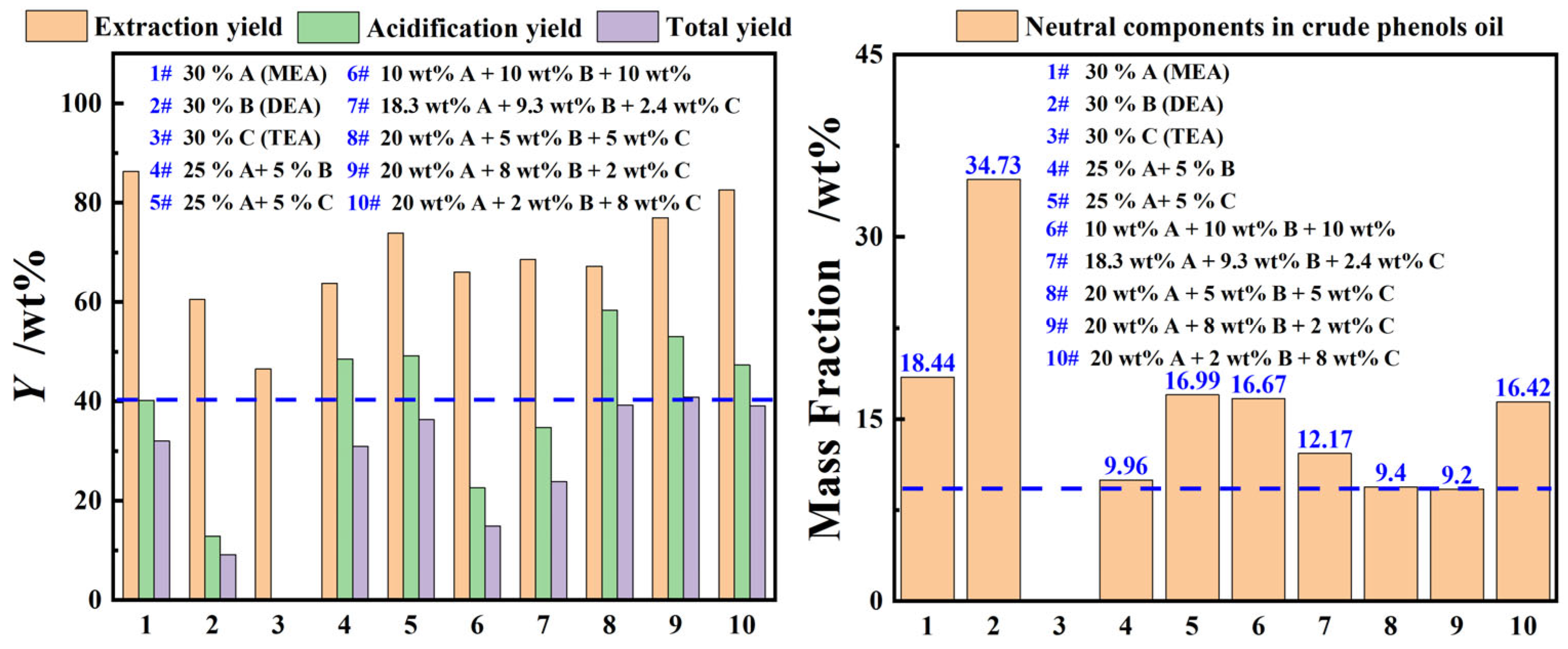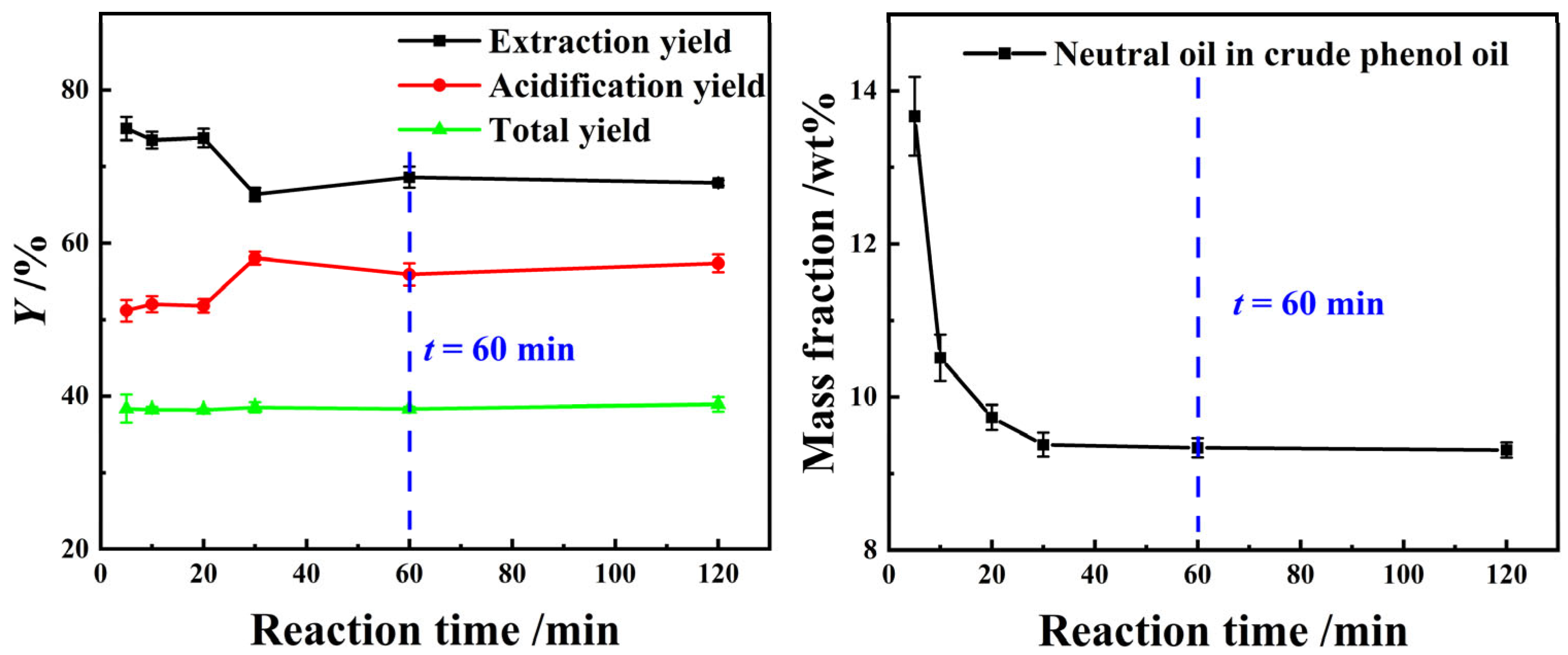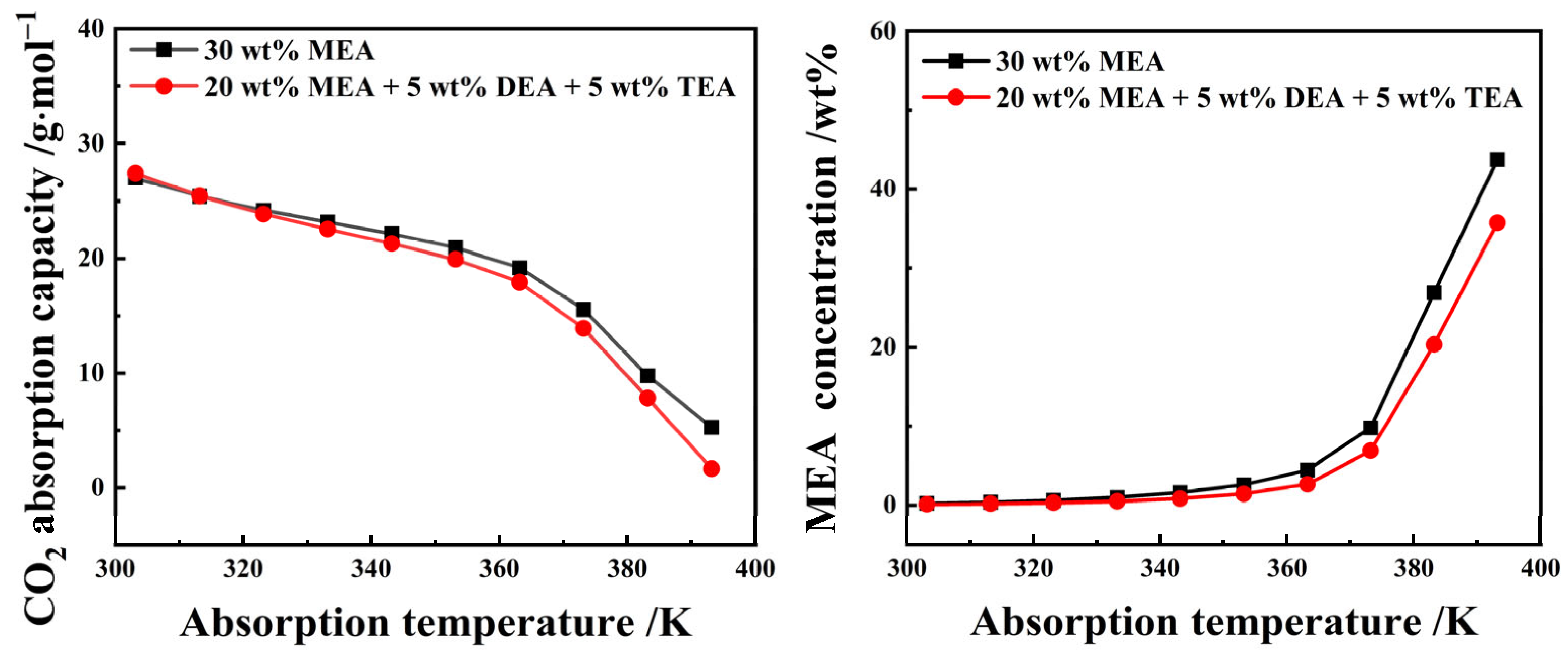Highly Efficient Extraction of Phenolic Compounds from Coal Tar Using Alcohol Amine Aqueous Solutions via Synergistic Extraction
Abstract
1. Introduction
2. Materials and Methods
2.1. Reagents and Analytical Method
2.2. Procedure
3. Extraction Mechanism
4. Results and Discussion
4.1. The Effect of Various Alkanolamine Solutions on the Phenolic Compounds Extraction Performance
4.2. The Effect of a Composite Alkanolamine Aqueous Solution on the Phenol Extraction Performance
4.3. The Effects of Process Parameters on the Phenol Extraction Performance
4.3.1. The Effect of Extraction Time on the Extraction Performance
4.3.2. The Effect of Extraction Temperature on the Extraction Performance
4.3.3. The Effect of Concentration and Phase Ratio on the Extraction Performance
4.4. The Absorption and Desorption Performance Evaluation
5. Conclusions
Supplementary Materials
Author Contributions
Funding
Data Availability Statement
Conflicts of Interest
Abbreviations
| MDEA | Methyldiethanolamine |
| DEAE | Diethylaminoethanol |
| MEA | Monoethanolamine |
| DEA | Diethanolamine |
| TEA | Triethanolamine |
| t | Reaction time |
| T | Reaction temperature |
| C | Concentration |
| β | Phase ratio |
| K | Reaction equilibrium constant |
| Ka | Distribution coefficient of organic amine |
| YP | The total yield of phenolic compounds |
| YE,P | The extraction yield phenolic compounds |
| Ya,P | The acidification yield of phenolic compounds |
| Yo | The extraction yield of neutral oil |
| CP | The mass quantities of phenols in the crude phenol oil |
| EP | The mass quantities of phenols in the extraction phase |
| RP | The mass quantities of phenols in the raffinate phase |
| MP | The mass quantities of phenols in the light coal tar |
| Ro | The mass quantities of neutral oil in the raffinate phase |
| Mo | The mass quantities of neutral oil in the light coal tar |
References
- Hou, Y.; Kong, J.; Ren, Y.; Ren, S.; Wu, W. Mass transfer dynamics in the separation of phenol from model oil with quaternary ammonium salts via forming deep eutectic solvents. Sep. Purif. Technol. 2017, 174, 554–560. [Google Scholar] [CrossRef]
- Ji, Y.; Hou, Y.; Ren, S.; Yao, C.; Wu, W. Highly efficient extraction of phenolic compounds from oil mixtures by trimethylamine-based dicationic ionic liquids via forming deep eutectic solvents. Fuel Process. Technol. 2018, 171, 183–191. [Google Scholar] [CrossRef]
- Lv, Q.; Ma, Y.; Yao, Q.; Sun, M. A Review on the Extraction of Phenols from Coal Tar: Composition Distribution and Analysis, Methods and Mechanism, Process and Industrialization Prospect. Energy Fuels 2024, 39, 1479–1506. [Google Scholar] [CrossRef]
- Yan, H.; Ma, H.; Li, X.; Dong, S.; Li, Q. Separation of higher-rank phenols from coal tar models: A combination of experiment and mechanism analysis. J. Chem. Thermodyn. 2025, 211, 107550. [Google Scholar] [CrossRef]
- Zhang, X.; Qi, X.; Wang, W.; Li, X.; Zhu, Z. Pyrolysis characteristics of pulverized coal in circulating fluidized bed with a multi-section variable-diameter riser. J. Anal. Appl. Pyrolysis 2025, 191, 107214. [Google Scholar] [CrossRef]
- Tian, Z.; Zhang, B.; Wang, Q.; Deng, Q.; Xu, G.; Ma, D. Effects of different heat carriers on pyrolysis products of high-sodium low-rank coal and optimization of pyrolysis process. Energy 2025, 325, 136095. [Google Scholar] [CrossRef]
- Ma, C.; Zhao, Y.; Guo, X.; Yao, R.; Zou, C.; Miao, Z. Pyrolysis behavior of low-rank coal in an H2-containing atmosphere and combustion properties of the prepared chars. J. Energy Inst. 2024, 114, 101581. [Google Scholar] [CrossRef]
- Li, Y.; Ai, Q.; You, K.; Zhao, F.; Xiao, W.; Luo, H. Modeling and simulating a new process for extracting phenols from model coal tar by low-boiling-point amine aqueous solutions. Fuel 2021, 299, 120921. [Google Scholar] [CrossRef]
- Morgan, J.J.; Meighan, M.H. Extraction of phenols from tar oils by the caustic soda process. Ind. Eng. Chem. 1925, 17, 696–700. [Google Scholar] [CrossRef]
- Chasib, K.F. Extraction of phenolic pollutants (phenol and p-chlorophenol) from industrial wastewater. J. Chem. Eng. Data 2012, 58, 1549–1564. [Google Scholar] [CrossRef]
- Ge, Y.Z.; Jin, H. Recovery process for phenolic compounds from coal-derived oils by ions of soluble metal salts. Fuel 1996, 75, 1681–1683. [Google Scholar] [CrossRef]
- Jiao, T.; Li, C.; Zhuang, X.; Cao, S.; Chen, H.; Zhang, S. The new liquid-liquid extraction method for separation of phenolic compounds from coal tar. Chem. Eng. J. 2015, 266, 148–155. [Google Scholar] [CrossRef]
- Yi, L.; Li, W.; Feng, J. Application of ionic liquid/low eutectic solvent in coal-based liquid separation. Chem. Ind. Eng. Prog. 2020, 39, 2066–2078. [Google Scholar]
- Amirfirouzkouhi, H.; Kharat, A.N. Application of ionic liquids as recyclable green catalysts for selective alkylation of phenol. Sep. Purif. Technol. 2018, 196, 132–139. [Google Scholar] [CrossRef]
- Yan, H.; Zhen, Y.; Zhang, A.; Li, T.; Lu, W.; Li, Q. Research on separation of higher-rank phenols from coal tar: A combination of liquid-liquid extraction experiments and mechanism analysis. J. Mol. Liq. 2024, 415, 126366. [Google Scholar] [CrossRef]
- Gao, D.; Hu, D.; Wang, X.; Abliz, A.; Bi, X.; Musa, B.; Wang, Q. Experimental and simulation studies on extraction and separation of phnolics from coal tar by deep eutectic solvents. Fuel 2025, 399, 135524. [Google Scholar]
- Li, Y.; Luo, H.; Ai, Q.; You, K.; Zhao, F.; Xiao, W. Efficient separation of phenols from coal tar with aqueous solution of amines by liquid-liquid extraction. Chin. J. Chem. Eng. 2021, 35, 180–188. [Google Scholar] [CrossRef]
- Perrin, D. Dissociation Constants of Organic Bases in Aqueous Solution; Butterworths: London, UK, 1972. [Google Scholar]
- Alner, D.; Smeeth, A. The dissociation constants of some substituted benzoic acids in aqueous solution at 25 °C. J. Chem. Soc. 1958, 1, 4128–4132. [Google Scholar]
- Monice, M.; Bart, H.; Wilma, F.; Donald, V.; Ronald, A.; Curtis, D.; Daniel, L.; James, G.; Ronald, C.; Thomas, J.; et al. Safety Assessment of Triethanolamine and Triethanolamine-Containing Ingredients as Used in Cosmetics. Int. J. Toxicol. 2013, 32, 59S–83S. [Google Scholar] [CrossRef]
- Lide, D.R. CRC Handbook of Chemistry and Physics, 83rd ed.; CRC Press Inc.: Boca Raton, FL, USA, 2002; pp. 8–49. [Google Scholar]
- Shiu, W.; Ma, K.; Varhaníčková, D.; Mackay, D. Chlorophenols and alkylphenols: A review and correlation of environmentally relevant properties and fate in an evaluative environment. Chemosphere 1994, 29, 1155–1224. [Google Scholar] [CrossRef]
- Serjeant, E.; Dempsey, B. Ionisation Constants of Prganic Acids in Aqueous Solution; Pergamon Press: Oxford, UK, 1972. [Google Scholar]
- Filburn, T.; Helble, J.; Weiss, R. Development of Supported Ethanolamines and Modified Ethanolamines for CO2 Capture. Ind. Eng. Chem. Res. 2005, 45, 1542–1546. [Google Scholar] [CrossRef]
- Zheng, W.; Luo, Q.; Liu, S.; Wang, L.; Luo, X.; Gao, H.; Liang, Z. New method of kinetic modeling for CO2 absorption into blended amine systems: A case of MEA/EAE/3DEA1P trisolvent blends. AIChE J. 2022, 68, e17628. [Google Scholar] [CrossRef]
- Zhang, Y.; Que, H.; Chen, C. Thermodynamic modeling for CO2 absorption in aqueous MEA solution with electrolyte NRTL model. Fluid Phase Equilibria 2011, 311, 67–75. [Google Scholar] [CrossRef]
- Ahad, G. Mass transfer and thermodynamic modeling of carbon dioxide absorption into MEA aqueous solution. Pol. J. Chem. Technol. 2017, 19, 75–82. [Google Scholar] [CrossRef]
- Shima, K.; Ahad, G.; Kambiz, T. Experimental and Thermodynamic Modeling of CO2 Absorption into Aqueous DEA and DEA+Pz Blended Solutions. Iran. J. Chem. Chem. Eng. 2021, 40, 1162–1178. [Google Scholar]








| Organic Amine | Phenolic Compounds | pKa1/25 °C [18,19,20] | pKa2/25 °C [21,22,23] | K */25 °C |
|---|---|---|---|---|
| MEA | phenol | 9.50 | 9.99 | 3.24 × 10−1 |
| o-cresol | 10.287 | 1.63 × 10−1 | ||
| 2,6-dimethylphenol | 10.59 | 8.13 × 10−2 | ||
| DEA | phenol | 8.96 | 9.99 | 9.33 × 10−2 |
| o-cresol | 10.287 | 4.71 × 10−2 | ||
| 2,6-dimethylphenol | 10.59 | 2.34 × 10−2 | ||
| TEA | phenol | 7.76 | 9.99 | 5.89 × 10−3 |
| o-cresol | 10.287 | 2.97 × 10−3 | ||
| 2,6-dimethylphenol | 10.59 | 1.48 × 10−3 |
Disclaimer/Publisher’s Note: The statements, opinions and data contained in all publications are solely those of the individual author(s) and contributor(s) and not of MDPI and/or the editor(s). MDPI and/or the editor(s) disclaim responsibility for any injury to people or property resulting from any ideas, methods, instructions or products referred to in the content. |
© 2025 by the authors. Licensee MDPI, Basel, Switzerland. This article is an open access article distributed under the terms and conditions of the Creative Commons Attribution (CC BY) license (https://creativecommons.org/licenses/by/4.0/).
Share and Cite
Li, Y.; Peng, B.; Yang, Y.; Ai, Q.; Zhou, J.; Wang, Y.; Liu, H.; Yan, W. Highly Efficient Extraction of Phenolic Compounds from Coal Tar Using Alcohol Amine Aqueous Solutions via Synergistic Extraction. Separations 2025, 12, 227. https://doi.org/10.3390/separations12090227
Li Y, Peng B, Yang Y, Ai Q, Zhou J, Wang Y, Liu H, Yan W. Highly Efficient Extraction of Phenolic Compounds from Coal Tar Using Alcohol Amine Aqueous Solutions via Synergistic Extraction. Separations. 2025; 12(9):227. https://doi.org/10.3390/separations12090227
Chicago/Turabian StyleLi, Yonglin, Bing Peng, Yeping Yang, Qiuhong Ai, Jiayi Zhou, Yong Wang, Huajie Liu, and Weiwei Yan. 2025. "Highly Efficient Extraction of Phenolic Compounds from Coal Tar Using Alcohol Amine Aqueous Solutions via Synergistic Extraction" Separations 12, no. 9: 227. https://doi.org/10.3390/separations12090227
APA StyleLi, Y., Peng, B., Yang, Y., Ai, Q., Zhou, J., Wang, Y., Liu, H., & Yan, W. (2025). Highly Efficient Extraction of Phenolic Compounds from Coal Tar Using Alcohol Amine Aqueous Solutions via Synergistic Extraction. Separations, 12(9), 227. https://doi.org/10.3390/separations12090227






